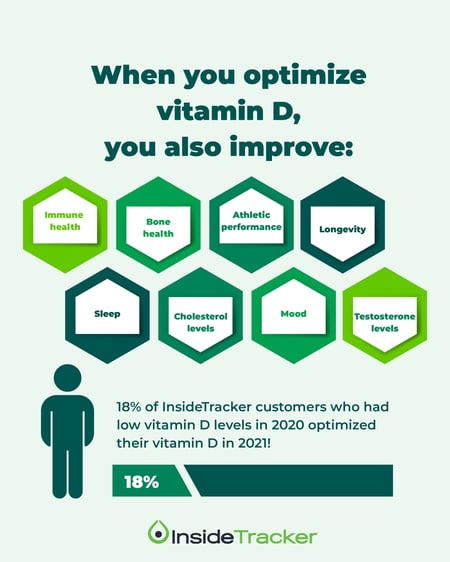![]() Vitamin D has become somewhat of a media hog in the past few years, but for good reason. While it tends to be highlighted for its prominent role in bone health, vitamin D provides other health benefits that should make athletes want to pay attention.
Vitamin D has become somewhat of a media hog in the past few years, but for good reason. While it tends to be highlighted for its prominent role in bone health, vitamin D provides other health benefits that should make athletes want to pay attention.
What’s the deal with Vitamin D?
First off, it’s important to know that most of your body’s vitamin D doesn’t come from food, as most other vitamins do. Few food sources contain vitamin D (in the form of calcitriol or vitamin D2), with the exception of fatty fish (think sardines, mackerel, and salmon), fortified milk, fortified breakfast cereal, eggs, butter, liver, mushrooms, some brands of margarine, and fish oil. Several of these foods only contain trace amounts of the vitamin, making it even harder to get as much as your body needs from food alone.
The miracles of science have allowed your body to get vitamin D another way- from the sun’s rays. The form of vitamin D that you get from the sun is called D3 (also known as cholecalciferol), which is derived from cholesterol. In order to use this form of the vitamin, your body tacks on a hydroxyl group (-OH) to create the active (or usable) form of vitamin D, known as D2.
But this process doesn’t come without its hiccups. The amount of D3 that you get from the sun depends on your skin pigment (dark-skinned individuals may block UV light and prevent D3 synthesis), geographic location (Boston Massachusetts receives less sunlight than Miami Florida), the use of sunscreen (people in Miami tend to apply sunscreen more liberally than those in Boston) and several other factors. This means that athletes who train in winter months and do not take vitamin D supplements have to rely on their bodies’ vitamin D stores, putting them at risk for deficiency.
Before you start popping vitamins, it’s also important to note that there are health complications associated with getting too much D. Studies suggest that taking too much vitamin D (more than 5,000 IU/day) could actually worsen athletic performance. For these reasons, it’s best to know what your vitamin D level is so you can choose the correct intervention. (The 25-hydroxy vitamin D test is the most accurate way to measure how much vitamin D is in your body and involves a simple blood sample, which is part of Segterra’s service.)
How can vitamin D enhance my performance?
As previously mentioned, vitamin D is linked to several beneficial health outcomes, most notably building strong bones along with the help of calcium. Inadequate calcium and vitamin D intake have been shown to decrease bone strength and may lead to stress fractures, breaks and osteoporosis. While athletes certainly should be concerned with building and maintaining bone density, vitamin D has additional benefits that may make athletes’ ears perk up.
In the last decade, it has become clear that the kidneys, as previously thought, do not exclusively produce D2. Locally produced D2 appears to directly affect numerous cells and tissues in the body. Like other steroid hormones, D2 turns on gene transcription, which has implications for the heart, lungs, muscle systems, pituitary, bones and the brain. It seems vitamin D may play a significant role in promoting overall human health.
Because of these findings, vitamin D has become a significant research topic, leading to a number of additional health discoveries. One study found that vitamin D acts directly on muscle to increase protein synthesis, which can lead to an increase in muscle mass, weight gain and a decrease in the rate of muscle fiber degradation. It has been shown to increase the size and number of Type II muscle fibers, while having low vitamin D levels weakens muscle fibers.
Adequate vitamin D levels improve lower body strength, specifically. And taking vitamin D with calcium can help you build strength, improve physical performance and prevent falls. The research shows that vitamin D improves athletic performance, peaking when 25-hydroxy-vitamin D levels peak.
 Who’s Deficient?
Who’s Deficient?
According to the government’s National Health and Nutrition Examination Survey, about three quarters of Americans are deficient. The Institute of Medicine recommended level of 25-hydroxy-vitamin D in the body is 30 ng/mL for adults with an upward limit of 74 ng/mL. To achieve this recommendation, the U.S. Food and Nutrition Board recommends getting 200 IU/day, but others recommend 600 to 2000 IU/day.
Segterra scientists have studied this topic exhaustively. They found that each of us has a personalized optimal vitamin D zone base on his or her goals and demographic information. For example: if you have low vitamin D (<50 ng/ml), you have a greater chance of having longer reaction time, less coordination, weaker muscle activity, and slower performance than someone with sufficient vitamin D. Women with very low vitamin D levels (<30 ng/ml) have significantly lower energy levels, slower walking speeds and poorer balance. On the other side, using sit and stand test researchers found that if you have high vitamin D (>60 ng/ml), you have a greater chance of having slower reaction time, less coordination, and weaker muscle activity than someone with sufficient vitamin D. Depending on your fitness and health goals, Segterra can help you find your optimal vitamin D level and work with you to get there.
